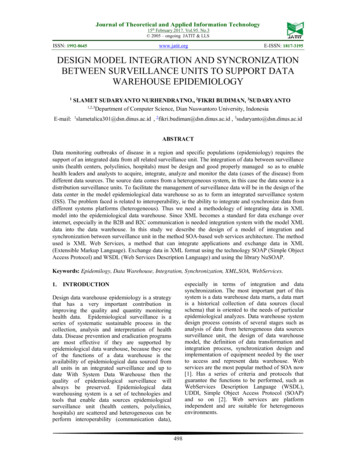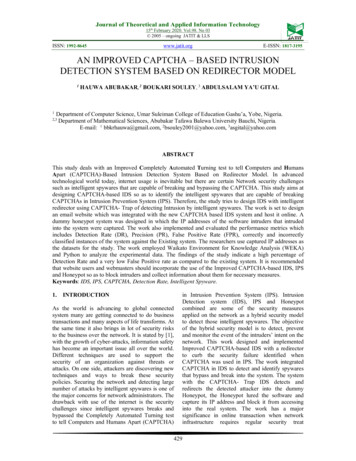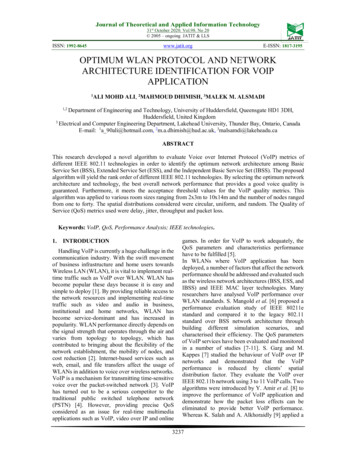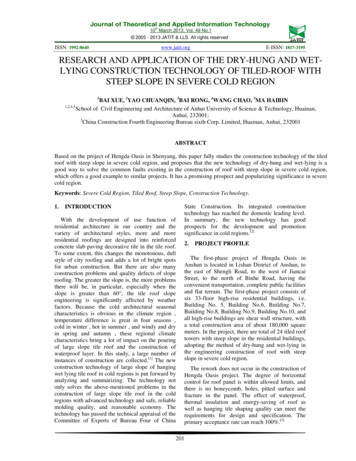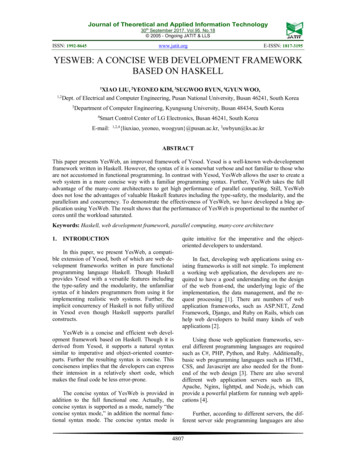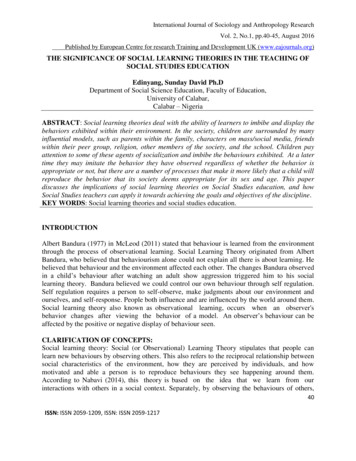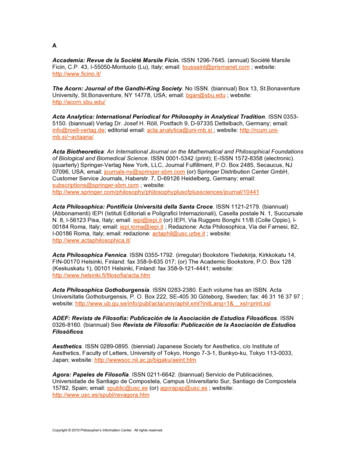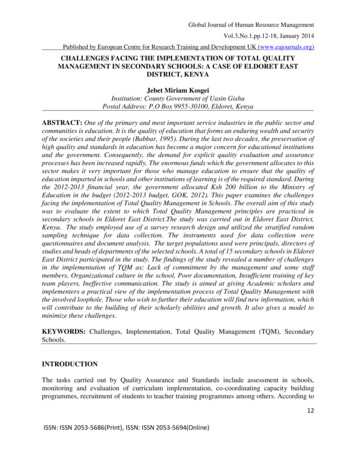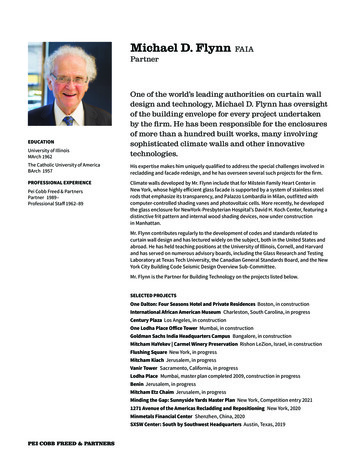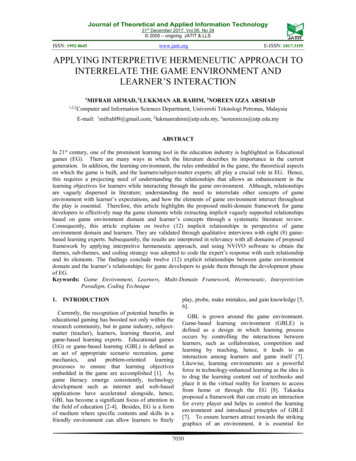
Transcription
Journal of Theoretical and Applied Information Technology31st December 2017. Vol.95. No 24 2005 – ongoing JATIT & LLSISSN: 1992-8645www.jatit.orgE-ISSN: 1817-3195APPLYING INTERPRETIVE HERMENEUTIC APPROACH TOINTERRELATE THE GAME ENVIRONMENT ANDLEARNER’S INTERACTION1MIFRAH AHMAD, 2LUKKMAN AB. RAHIM, 3NOREEN IZZA ARSHADComputer and Information Sciences Department, Universiti Teknologi Petronas, Malaysia1,2,3E-mail: 1mifrah09@gmail.com, 2lukmanrahim@utp.edu.my, 3noreenizza@utp.edu.myABSTRACTIn 21st century, one of the prominent learning tool in the education industry is highlighted as Educationalgames (EG). There are many ways in which the literature describes its importance in the currentgeneration. In addition, the learning environment, the rules embedded in the game, the theoretical aspectson which the game is built, and the learners/subject-matter experts; all play a crucial role in EG. Hence,this requires a projecting need of understanding the relationships that allows an enhancement in thelearning objectives for learners while interacting through the game environment. Although, relationshipsare vaguely dispersed in literature; understanding the need to interrelate other concepts of gameenvironment with learner’s expectations, and how the elements of game environment interact throughoutthe play is essential. Therefore, this article highlights the proposed multi-domain framework for gamedevelopers to effectively map the game elements while extracting implicit vaguely supported relationshipsbased on game environment domain and learner’s concepts through a systematic literature review.Consequently, this article explains on twelve (12) implicit relationships in perspective of gameenvironment domain and learners. They are validated through qualitative interviews with eight (8) gamebased learning experts. Subsequently, the results are interpreted in relevancy with all domains of proposedframework by applying interpretive hermeneutic approach, and using NViVO software to obtain thethemes, sub-themes, and coding strategy was adopted to code the expert’s response with each relationshipand its elements. The findings conclude twelve (12) explicit relationships between game environmentdomain and the learner’s relationships; for game developers to guide them through the development phaseof EG.Keywords: Game Environment, Learners, Multi-Domain Framework, Hermeneutic, InterpretivismParadigm, Coding Technique1.play, probe, make mistakes, and gain knowledge [5,6].INTRODUCTIONCurrently, the recognition of potential benefits ineducational gaming has boosted not only within theresearch community, but in game industry, subjectmatter (teacher), learners, learning theorist, andgame-based learning experts. Educational games(EG) or game-based learning (GBL) is defined asan act of appropriate scenario recreation, gamemechanics,andproblem-orientedlearningprocesses to ensure that learning objectivesembedded in the game are accomplished [1]. Asgame literacy emerge consistently, technologydevelopment such as internet and web-basedapplications have accelerated alongside, hence,GBL has become a significant focus of attention inthe field of education [2-4]. Besides, EG is a formof medium where specific contents and skills in afriendly environment can allow learners to freelyGBL is grown around the game environment.Game-based learning environment (GBLE) isdefined as a design in which learning processoccurs by controlling the interactions betweenlearners, such as collaboration, competition andlearning by teaching, hence, it leads to aninteraction among learners and game itself [7].Likewise, learning environments are a powerfulforce in technology-enhanced learning as the idea isto drag the learning content out of textbooks andplace it in the virtual reality for learners to accessfrom home or through the EG [8]. Takaokaproposed a framework that can create an interactionfor every player and helps to control the learningenvironment and introduced principles of GBLE[7]. To ensure learners attract towards the strikinggraphics of an environment, it is essential for7030
Journal of Theoretical and Applied Information Technology31st December 2017. Vol.95. No 24 2005 – ongoing JATIT & LLSISSN: 1992-8645www.jatit.orgE-ISSN: 1817-3195graphic design to perform multiple tasks forlearners to explore and indulge through thescenario.It is clear that learners prefer realistic scenarios,where they are provided with a good set of rulesand regulations to follow, objectives to be achievedof a subject that is embedded and a strong learningtheories base to ensure their learning ability isproductive.Thus, GBL researchers shouldunderstand the depth of the structures of underlyingexperience that can contribute to the learning flow,hence, build a game environment through a processof modelling, which depends on multiple criteriasuch as how one element can relate to anotherelement or types of domains which are embeddedin EG.There are relationships that exist amongst thelearners who play the EG and the environment ofEG; and they are vaguely dispersed in the literature.The relationships are crucial when the gamedevelopers initiate the development of EG, theyneed to ensure all related concepts and techniquessuch as collaboration between elements anddomains is effectively pre-model. Hence, there is aneed to provide an explicit idea which is based onEG domains and their relative components; whichcan be modelled in a way which can provide apromising approach towards delivering an effectiveEG environment and an experiential outcome forlearners.2.LITERATURE REVIEWGame environment defined as a part of the gamethat allows the learners to discover new rules andideas rather than memorizing. This can be done byexploring, experiencing and experimenting toprovide intrinsic reward [9].Designing anddeveloping a learning environment evolves manyother components to provide the desiredrequirements. Gros has proposed a method thatneeds four types of actions to create an shment of learning objectives and theactivities/tasks to be carried out, (2) Reflection, thecomparison of results obtained from groups, (3)Activity, particularly designed for the games whichmay involve other educational materials to be usedas reference such as books, or the internet etc., (4)Discussion, relying on the reflection on the actualprocess of learning, gaining knowledge, and thejoint discussion related to the proposed activities[2].Figure 1: Elements to create effective environmentTo provide a learning environment that can coverall the aspects to achieve an effective EG is achallenging task for game developers as there existsa variety of learning environments. Collaborativeenvironment which allows learners to encounterand solve the challenges in an emotive environmentwhich means, while they solve the challenges, theyalso engage themselves through feelings such asenthusiasm, competition, aggressiveness, andcuriosity [10, 11]. Literature also emphasize oninstructional environment where a game shallinclude skills, knowledge and values for thelearners to gain experience of a different kind ofprofession as they solve challenges through the EG[12].Multi-User Virtual Environment (MUVE) are thecombination of guidance and instructional theory toimprove learning through game [13]. Nelsonelaborated that guidance is accommodating tacit,reflective, and collaborative factors, while relatingstudent self-efficacy to improve the learningoutcomes of students. VISOLE (Virtual interactivestudent-oriented learning environment) has threeidentified principles, namely, realistic game,motivational elements, and compatibility to provepositive perception and encroachment in subjectspecific[14].An environment which is friendly indicates that itcombines content and skills to provide a betterinteractivity in games [8].Other learningenvironments includes: (1) Authentic environmentswhere the game reflects the real world bypresenting a complex task in scenarios[15], (2)Multimedia learning environment which combinesgesture, sound, fun, fantasy, and multi-taskinginterface for learners [16, 17], (3) Immersiveenvironment that allows connection between gamecomponents as a whole and links the player along[18], (4) Simulated and interactive learningenvironment as a fundamental part of knowledgeand intellectual expansion but it can also be adistraction to some learners [19]. The gamecomponents that can collaborate with learningenvironment are presented in the proposedframework (Figure. 1). Social capital is a gamecomponent which is highly related to learning7031
Journal of Theoretical and Applied Information Technology31st December 2017. Vol.95. No 24 2005 – ongoing JATIT & LLSISSN: 1992-8645www.jatit.orgenvironments.It combines collaboration,teamwork, competition among players, and itallows players to choose their avatars according totheir desires while connecting their emotions withthe avatar to complete the objective or task given,hence, share their understanding on the learningoutcome achieved [10].inclusivecontents andplotsInstructionalenvironmentGame environment has the ability to involveevery other component and combine them toprovide an ambiance that will give the learner amotivation to continue with task to achieve goals.For example, if the environment is instructional, itwill be able to provide learner with instructions tocomplete complex level or be productive to followinstructions throughout the game level. There arevariousnumbersofdomainsandelements/components that needs to be planned.When EG is in development process, there is a needof game designers, developers, educators, subjectmatter, game-based learning experts and learningtheorist to combine their perspectives towardsachieving a goal effectively. The game developersneed to plan on how they can extract a model ofEG. To proceed to development of EG based onthe conceptualized model is a very crucial task forgame developers. Table 1 describes the componentsunder game onment(gesture,sound, ntGame designComplexscenarioTable 1: Game Environment Components and onmentFriendlyGame environment reflecting the realworld with complex tasks.A friendly environment can combinecontent and skills to use all fourfactors of game.Genre of a game and how it ismodeled with other domains is veryimportant in collaboration withenvironment. Genre helps to evolvethe concepts, contents and objectivesexpected to be achieved.These can be distraction or afundamental part of knowledge andintellectual emsolving.Gamingexperience.Game levels.Gender/raceAchieved by player when a goal iscompleted. This also helps to assessthe assessment, knowledge skills orthe ability at each point in the game.A game environment allowingplayers to engage in problem solvingchallenges and experience a realisticin-game experience. Once a problemis solved, the players move to thenext game level.Gender differentiation should beE-ISSN: designSocial capitalenvironmentGame typesdesigned in the game to keep track ofthe actors/character in the game. Thestory/subject/topic of the gameembedded in the game for thelearner/player to understand at thecompletion of the activity.A game shall include skills,knowledge and values for learner togain experience of a differentprofession perform and solveproblems.Speediness and easiness of use.The graphic design of the educationalgame is a factor of attracting theplayers to indulge in the game.Players/students’ prefer exploratorytask where the information is inmultiple form. Multimedia learningenvironmentmustbehighlyconsideredThe components connect andcombine as a whole to maintain alink between the player and thegame.It is based on the way in which thedesign elements are implementedinside the game to provide aninteractive and amusing way oflearning [20].A game environment exhibitingcomplex real world scenario toprovide a realistic interface forlearner's to engage them.Playing game is referred to assolving challenges in an emotive andcollaborativeenvironment.Collaborative environment is theenvironment that must be blendedinto the game in order to ensure theplayer'scommunicationandinteraction to solve problems orchallenges effectively.Interactive is one of the fun elementsof the game to keep the interactionbetween the player and the game.An environment with supportinglearning and shared understanding.This involves players, characters,collaboration among them, and thecombination of them workingtogether.Such as action-based, complex,interactive events, non-interactiveevents, effective and motivatinginstructional.The value of subject-matter/learners is stressed inmany literatures when the development of game isconcerned. They are described in many different7032
Journal of Theoretical and Applied Information Technology31st December 2017. Vol.95. No 24 2005 – ongoing JATIT & LLSISSN: 1992-8645www.jatit.orgcontexts of the educational games. Some literaturemakes subject-matter as the course/syllabus beingused in the content of game, whereas, some use theterm as learner or educator or teacher. Table 2describes the elements.Table 2: Subject-Matter Components and theirDescriptionComponentSkillAssessmentLearning outcomeMoral abusandThe course content in theeducational game plot.This contains both the preknowledge and post knowledge ofthe learner before and after playinggame.KnowledgeAttention,observation,complex riptionThe level of player’s skill andapplying them in an activity of agame.It is in a form of puzzle or quest, totest the skills and knowledgegained.The objective set by the gameitself to achieve at the end of atopic or a module of the game.The values or the outcome that thelearners learn throughout thegame.Pathway students take to learn aset of knowledge i.e., the order inwhich they develop their skills.skillThese belong to the values andtypes of thinking the learner goesthrough while being in theeducational game.The ability to solve and handlechallenge to balance them easily.Learner’s performance can beassessed through assessments tofind their abilities or knowledgethey have gained.MULTI-DOMAIN FRAMEWORK ANDIMPLICIT RELATIONSHIPSThe authors have proposed a Multi-domainframework for modeling the educational gameseffectively (Figure 2). The framework has beenproposed which states the 95 relationships based onthe 4 domains and their occurrence in literatureE-ISSN: 1817-3195[21]. Therefore, this article briefly explains aboutthe multi-domain framework. It was designed anddeveloped as a result from systematic literaturereview (SLR) based on 15 existing frameworks andmodels (Table 3). The frameworks and modelswere reviewed based on four (4) major division.Multi-domain framework has four major domains:(1) Game play (GP), (2) Game environment (GE),(3) Subject-matter (SM), and (4) Learning Theories(LT). The proposed multi-domain framework has153 game components defined under each domainaccording to the definition of the domain as shownin Figure 2.Table 3 shows fifteen (15) frameworks andmodels reviewed under five (5) different concepts,namely, developing game design[8, 22, 23], welldesigned game[24], effective video game [25],learning theories [26] and key elements of game[20]. Out of 27 elements altogether, there were two(2) frameworks which covered nine (9) elements:Serious-game design model [27] and Garris Gamebased learning model [28]. Only educational gamedesign model has 11 elements and conceptualmodel for 3D multi-agent technology has 12elements. Osman and Bakar design model [29]has 13 elements out of 27. Fourteen (14) elementswere found in two (2) frameworks, namely, learnercentered learning [30] and framework of flow incomputer-mediated environment [31, 32].DGBL model for history educational gamedesign [33] managed to have fifteen (15) elementscovering the framework.Four-dimensionalframework [34, 35] covers sixteen (16) elements inthe framework. There are two (2) frameworkscovering seventeen (17) elements out of 27elements, namely, the Staalduinen and Freitasframework [36] and six-steps model to designserious games [37]. The most surprising aspect tonotice is that there are four (4) frameworkscovering twenty-three (23) elements, i.e., gameobject model 2 [10], experiential gaming model[38], FIDGE model [39], and “I” model[40].7033
Journal of Theoretical and Applied Information Technology31st December 2017. Vol.95. No 24 2005 – ongoing JATIT & LLSISSN: 1992-8645www.jatit.org7034E-ISSN: 1817-3195
Journal of Theoretical and Applied Information Technology31st December 2017. Vol.95. No 24 2005 – ongoing JATIT & LLSISSN: 1992-8645www.jatit.orgTo conclude from above visualization, themaximum number of elements of design,theoretical aspects, environmental aspects, subjectmatter concepts and effective game design elementswere twenty-three (23) out of twenty-seven (27).The elements that are mostly not considered indeveloping or designing models and fication, adaptive challenges and control.Another observation from the Table 3 is that mostframeworks do not consider the major learningtheories mentioned. This aspect needs to beimproved as there is a great need of providing astrong base of an EG.With reference to the proposed multi domainframework, this article discusses implicitrelationships which are vaguely supported byliterature and they are not explicitly mentioned.Therefore, the selected twelve (12) relationships aremapped upon the game environment domain whichare then validated by GBLE. The Table 4 showsthe twelve (12) implicit relationship statementswith highlighted (bold) game components fromframework.Table 4: The implicit relationships which are vaguelysupported#123456789Implicit RelationshipsEducational game should adaptplayer's learning process toenhance learning experience.Students prefer rich graphics,multi-taskinginterfaceandcompeting environment to improveself-determination.Learning environment is moreproductive if it is multi-user.Learners prefer rich graphics,animated designs, and interfacesshowing multi-type of information.Rich graphic can also be adistraction to learners to ratherfocus on.Games and stories are not the same.Games provide interaction andstories provide narrative context ofgames.Therelationshipbetweenreader/story is different to thatbetween player/game.Well-designed games are able toexpose learners with complex tasksandprofessionaldiagnosticfeedback to provide narrativecontent efficiently.Co1mplex games are able toRefMcClarty et al.,2012Amory,2007Hirumi&Stapleton, 2009McClarty et al.,2012KristianKiili,2005McClarty et al.,2012Amory,2007KristianKiili,2005Amory,E-ISSN: 1817-3195provide new strategies for learnersto solve ethical dilemma.10 Digital games are able to teach the'future' skills for future jobs such ascollaboration,problem-solving,and communication.11 A learning environment should bediscovery of new rules and ideas,not memorizing.12 Well-designed games are able toprovide a diagnostic feedback andintegrated learning experience inthe actions that the learners take.4.2007Hirumi H METHODOLOGY4.1 The Research DesignInitially, a multi-domain framework wasproposed as a result of systematic literature review(SLR)[41]. Systematic literature review (SLR) isthe method used in reviewing the literature andselecting the most pertinent literature with theobjective of proposing a new framework foreducational game design. There are five (5) stepsproposed by [42], which assisted the authors to do abroad search of the literature performed throughinternet resources such as Google Scholar, IEEEXplore, ACM Digital Library and Springer Linkusing keywords such as ‘educational games’,‘framework’, ‘design framework’, ‘game design’,and ‘developing models’. The literatures collectedfrom the broad search were narrowed further toliteraturesthatdiscussedaboutelements/components of EG necessary through thedevelopment process. Further literature search isconducted for the authors to have betterunderstanding of the elements.Figure 3: Five steps adopted to conduct SLR4.1.1Samples and instrument of the studyThe multi-domain framework is composed offour major domains: (1) Game play (GP), (2) Gameenvironment (GE), (3) Subject-matter (SM), and (4)Learning Theories (LT). Each domain is composedof game components categorized according to the7035
Journal of Theoretical and Applied Information Technology31st December 2017. Vol.95. No 24 2005 – ongoing JATIT & LLSISSN: 1992-8645www.jatit.orgdomain's definition. The extraction of relationshipswas more puzzling as they are not explicitlymentioned in literature. The authors used theNVIVO software to code the literatures that containthe educational games elements and domains. Inother words, the elements in the domains were themain coding synonyms. Using the codingtechnique, sentences containing the elements werehighlighted. These sentences were extracted andfurther analyzed to discern the sentences whichwere then known as the implicit relationshipsbetween elements.To validate the implicit relationships and theframework ability to map out those relationships,the authors selected eight (8) game-based learningexperts (GBLe) for the qualitative interviews tounderstand their experience over this research field.GBL experts interviewed include lecturer, seniorlecturer, associate professor and post-doctoralresearchers in the field.Table 5 providesinformation of the experts, however, due toconfidentiality reasons; their initials were changedaccordingly.E-ISSN: 1817-3195its relationships as sub-themes. Each relationshiphas its components and those components are theexisting "nodes" (highlighted as bold) in Table 4.The results and discussions of each relationship ispresented by applying interpretive hermeneuticapproach of qualitative study to understand indepth of how each relationship of game playdomain can relate to other domains of educationalgames.Interpretive hermeneutic method ve of qualitative study, which allowsunderstanding of in-depth experience of experts inthis research area study [43-51]. Interpretivism isdescribed as the belief in multiple observations ofreality, subjective and socially constructed throughlanguage, consciousness and shared meaning [5254].Table 5. Details of GBLe interviewedFigure 4: Show the Interview Process Interrelated inHermeneutic MethodThe goal is to conduct and develop anunderstanding of social life and discover howpeople (experts) construct the meaning in naturalsetting to accomplish what people perceive it to be[55, 56]. In addition, hermeneutics is mainlydescribed as putting the “parts” of the “whole”research together which are described by differentexperts in the field of research area [46, 51, 57-69].4.2 Data CollectionThere were 96 responses collected by eachexperts for validating twelve (12) relationships.The data collected was then transcribed and codedinto NVIVO software to understand the emergenceof new "nodes" in each relationship. Each domainof framework is the major theme. This paperdiscusses game environment as a major theme andTo ensure that the selected relationships arecrucial and they need to be explicitly mentioned.To support the interpretations, the same analyzeddata is preserving both hermeneutic and statisticallyto first analyze it qualitatively and then, it isdisplayed quantitatively within one single researchprocess [70-73]. In other words, the authors haveto transform the analyzed data (the qualitativeinterviews into themes, nodes and emerging nodes);into categories or codes or synonyms to representquantitative data [74]. Thus, the authors havecategorized each relationship into five (5) types ofresponses by the experts, namely: (1) StronglyAgree, (2) Agree, (3) Neutral (agreed but withsome additional comments), (4) Disagree, and (5)Strongly Disagree. Lastly, there are 12 explicitrelationships that shall be considered by gamedevelopers in developing process of EG when they7036
Journal of Theoretical and Applied Information Technology31st December 2017. Vol.95. No 24 2005 – ongoing JATIT & LLSISSN: 1992-8645www.jatit.orgconsider game environment domain with learner’sconcept.4.3 Data Preparation and Software for tation, the data was prepared bytranscribing the interviews recorded using a digitalrecorder, in detail dialog and dictated byhermeneutic circle, which characterizes the processof analysis. The researcher then typed and inputthe transcripts into qualitative analytical softwareknown as QSR NVIVO. This software assists inorganizing raw data (interviews, observations,pictures, recordings, and field notes) and links themwith memos and "data bites" where researchersmight make codes and analytical notes, and thenedit and report ideas as the research studyprogresses [75-77]. In addition, QSR NVIVOsoftware enables the researcher to link, search, andsort the data, and reports it according to thehermeneutic method.Figure. 5, show thetranscription screen with major themes and theirsub-themes.E-ISSN: 1817-3195Open coding begins by identifying and labellingmanuscripts for concepts and categories. Theconcept is ‘words stand for ideas’, which resultedfrom the interpretation. It is the basic unit of theorydevelopment and sometimes referred to ascodes[79, 80]. Each sub-theme has pre-definednodes, while they were coded with new emerging"nodes" that were highlighted by expertsindividually. As hermeneutic circle was adopted,identifying and considering the features of words,sentences, and paragraphs from the transcriptionwas coded thoroughly. As the number of interviewtranscripts increased, the merging nodes for eachsub-theme was observed.The concepts werecompared thoroughly by each expert's experienceand opinion to understand further clarification onthe relationships. This iterative process providesnew interrelationship among the sub-themes andtheir nodes that are coded. This reflects theReflective Writing in hermeneutic circle.Another article by Harris stated that thehermeneutic circle is "the pattern that develops inthe dialogue between us and our world: we canunderstand the whole of something only in terms ofits parts and the parts only through theirrelationship to the whole" [69]. A change ofunderstanding in one pole, the whole or parts,triggers a change in understanding at the other pole,forcing us into an interpretive (hermeneutic) loop(Figure. 6)Figure 5: Transcription of experts interviews (on theright) with major themes and their sub-themes (on theleft)Although, this software has facilitated themanagement of data, the intellectual processes ve writing, and reading were completedsolely by the researcher. It is also capable ofcreating emerging nodes and coding them with thetranscript text individually (idiographic levelanalysis) and across multiple expert views(nomothetic analysis, see Figure 5. Coding is theprocess of organizing the raw materials (interviewstranscripts) into chunks or segments of text beforebringing meaning to information [55, 78]. Therewere four (4) major themes (dimensions ofproposed Multi-domain framework) and minorthemes (12 relationships) that were sorted andcoded throughout the analysis. Hence, open codingis adopted to accommodate idiographic level andnomothetic level analysis.Figure 6: Hermeneutic Loop or circle (Harris, 2014)Data analysis is often performed by applying thehermeneutic cycle that constitutes of reading,reflective writing and interpretation in a rigorousfashion [65]. This process can be demonstrated asin the given Figure 7.Although the principlehermeneutic circle is known for its infinite processof interpretation, however, it may end in practicewhen there is a sensible meaning, a coherent7037
Journal of Theoretical and Applied Information Technology31st December 2017. Vol.95. No 24 2005 – ongoing JATIT & LLSISSN: 1992-8645www.jatit.orgE-ISSN: 1817-3195understanding, free of inner contradictions has beenreached [81].Figure 9: Nomothetic level analysis of Set C overviewFigure 7: Hermeneutic cycle adopted [68]Once the idiographic level analysis is completed(individual level analysis) the themes and nodesemerge clearly (Figure 8). The ideal situation is toanalyse an interview immediately subsequent to itscompletion and prior to conducting the nextinterview, in case there are insights to be gainedthat would help improve the next interview. Thisalso reflects the hermeneutic circle as eachindividual expert's experience is coded into thenodes and interpreted.Figure 8: Idiographic level analysis of Set C overviewTo identify and interpret the major themes, subthemes and nodes, this research presentsnomothetic (across individual) analysis (Figure 9).It is an extension of idiographic level whichcaptures the range of individual perspective andtheir experience towards the relationship of thephenomena (GBL). The output of idiographic levelprovided the emerging nodes. The emerging nodesare expressed by GBLe and this also identifieswhich relationship has nodes coded by multipleGBLe. Hence, it covers the goal of hermeneuticcircle and validates the proposed multi-dimensionframework with respect to 12 relationships.In addition, the QSR NVIVO software isdeveloped by Qualitative Solutions & ResearchInternational (QSR) is used at constant manner toconfirm the descriptive and coding of sub-theme,hence, it consequently assists in interpretivehermeneutic approach of this study. NVIVOsoftware is also used to
challenging task for game developers as there exists a variety of learning environments. Collaborative environment which allows learners to encounter and solve the challenges in an emotive environment which means, while they solve the challenges, they also engage themselves through feelings such as enthusiasm, competition, aggressiveness, and


